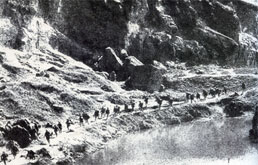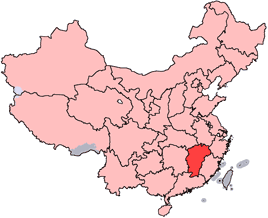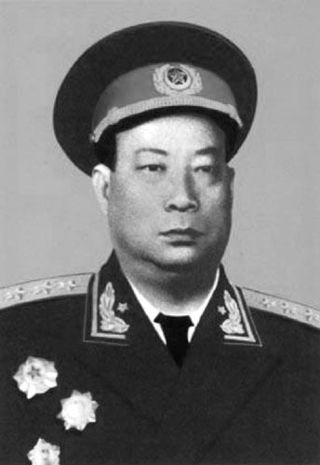
The Long March was a military retreat by the Chinese Red Army and Chinese Communist Party (CCP) from advancing Kuomintang forces during the Chinese Civil War, occurring between October 1934 and October 1935. About 100,000 troops retreated from the Jiangxi Soviet and other bases to a new headquarters in Yan'an, Shaanxi, traversing some 10,000 kilometres. About 8,000 troops ultimately survived the Long March.

The New Fourth Army(N4A) was a unit of the National Revolutionary Army of the Republic of China established in 1937. In contrast to most of the National Revolutionary Army, it was controlled by the Chinese Communist Party and not by the ruling Kuomintang. The New Fourth Army and the Eighth Route Army were the two main communist forces from 1938. The New Fourth Army was active south of the Yangtze River, while the Eighth Route Army was based in Yan'an in the northwest.

The Battle of Xinkou was a decisive engagement of the Taiyuan Campaign, the second of the 22 major engagements between the National Revolutionary Army and Imperial Japanese Army during the Second Sino-Japanese War.

Honghu is a county-level city in the municipal region of Jingzhou, in the central south of Hubei province. The city lies on the northwest (left) bank of the Yangtze River, across from Hunan Province and Xianning, Hubei. It is named after the adjacent Hong Lake, which since ancient times has periodically flooded.
The encirclement campaigns of the Chinese Civil War were Republic of China (ROC) offensives against Chinese Communist Party (CCP) revolutionary base areas in China from the late-1920s to 1934 during the Chinese Civil War.
The Campaign of the North China Plain Pocket, also called the Breakout on the Central Plains by the Chinese Communist Party, was a series of battles fought between the nationalists and the communists during the Chinese Civil War, resulting in a successful communist breakout from the nationalist encirclement. The campaign marked the beginning of the full-scale civil war fought between the communists and the nationalists in the post-World War II era.
The Battle of Guanzhong (关中战斗) was fought between the nationalists and the Chinese Communist Party (CCP) during the Chinese Civil War in the post-World War II era and resulted in CCP victory.
Campaign to Suppress Bandits in Dabieshan was a counter-guerrilla / counterinsurgency campaign the communists fought against the nationalist guerrilla that was mostly consisted of bandits and nationalist regular troops left behind after the nationalist regime withdrew from mainland China. The campaign was fought during the Chinese Civil War in the post-World War II era in the region of Dabieshan and resulted in communist victory. This campaign was part of Campaign to Suppress Bandits in Central and Southern China.
Campaign to Suppress Bandits in the Border Region of the Hubei-Hunan-Sichuan (湘鄂川边剿匪) was a counter-guerrilla/counterinsurgency campaign that the Communists fought against the Kuomintang guerrilla left behind after the nationalist government withdrew from mainland China. The campaign was actually fought after the Chinese Civil War was declared over by the PRC in Beijing a year earlier, and took place in the border regions of the following three Chinese provinces: Hubei, Hunan, and Sichuan, and resulted in communist victory. This campaign was part of Campaign to Suppress Bandits in Central and Southern China.
The first encirclement campaign against the Hubei–Henan–Shaanxi Soviet was an encirclement campaign launched by the Nationalist Government of China against the Communist Party's Hubei–Henan–Shaanxi Soviet and its local Red Army. The Red Army successfully defended the Soviet against Nationalist attacks from January to February 5, 1935.
The second encirclement campaign against the Hubei–Henan–Shaanxi Soviet was an encirclement campaign launched by the Nationalist Government of China against the Communist Party's Hubei–Henan–Shaanxi Soviet and its local Red Army. The Red Army successfully defended the Soviet from February 1935 to April 18, 1935.

The third encirclement campaignagainst Jiangxi Soviet was the third campaign launched by the Chinese Nationalist Government in the hope of destroying the Red Army in Jiangxi. It was launched less than a month after the previous campaign failed. However, this encirclement was repelled by the Red Army's third counter-encirclement campaign at the Central Soviet, also called as the third counter-encirclement campaign at the Central Revolutionary Base.
The encirclement campaign against the Hunan-Jiangxi Soviet was an encirclement campaign launched by the Nationalist government against the Communist Party of China's Hunan-Jiangxi Soviet. The Chinese Red Army successfully defended the Soviet against the Nationalist attacks from January 29 to March 24, 1931.

The encirclement campaign against the Hunan-Hubei-Jiangxi Soviet was a military campaign launched by the Kuomintang Nationalist Government against the communist Soviet force in the Hunan-Hubei-Jiangxi. It was responded to with the Communists' Counter-encirclement campaign at the Hunan-Hubei-Jiangxi Soviet, also called their Counter-encirclement campaign at the Hunan-Hubei-Jiangxi Revolutionary Base. The local red army successfully defended this soviet republic against the government attacks from December 1930 through to May 1931.

The Hunan–Hubei–Jiangxi Soviet was a Comintern and local communist-led liberated zone in the 1930s south of the Yangtze River, comprising parts of counties in what are now the municipal regions of Yueyang in Hunan, Xianning in Hubei and, in Jiangxi, Jiujiang and Yichun. It was a constituent part of the territorially discontiguous and diplomatically unrecognised Chinese Soviet Republic (CSR). Before the declaration of the CSR in November 1931, the liberated zone had been known to Communists as the Hunan-Hubei-Jiangxi (Xiang-E-Gan) Revolutionary Base Area (湘鄂赣革命根据地).

The encirclement campaign against the Hunan–Western Hubei Soviet was an encirclement campaign launched by the Chinese Nationalist Government that was intended to destroy the communist Hunan–Western Hubei Soviet and its Chinese Red Army in the local region. The Communists' responded by launching the Counter-encirclement campaign at Hunan–Western Hubei Soviet, also called by the communists as the Counter-encirclement campaign at Hunan–Western Hubei Revolutionary Base, in which the Nationalist force defeated the local Chinese Red Army and overran the communist base in the southern Hubei and Hunan provinces from November 1930 to January 1931. Since the bulk of the fighting was fought at the second stage of the campaign, concentrated at the heart of the communist base, the Honghu region of Jingzhou, the campaign is therefore also frequently referred as the Fourth encirclement campaign against Honghu Soviet and the Fourth Counter-encirclement campaign at Honghu Revolutionary Base by the communists, or Fourth Counter-encirclement campaign at Honghu Soviet for short.

Lu Dongsheng who was born in Xiangtan County, Hunan Province, China was the Chinese commander of the pistol company of the headquarters of the Fourth Red Army, the battalion commander of the pistol group, the battalion commander of the guarding battalion of the Second Red Army, the commander of Regiment Twenty-Seven of Division Seven of the Third Red Army, the political commissioner of the Independent Division of Hu'nan and Hubei Area, the commander of the Fourth Division of the Second Red Army, the commander of Force 358 of the Division 120 of the Eighth Route Army and the commander of Songjiang Military Command of Northeast People Autonomous Army. After the Northern Expedition, Anti-Encirclement Campaigns, the Great Expedition, and studying in the Soviet Union, Lu was killed by two Soviet soldiers in Ha'erbing city in 1945.

He Bingyan was a colonel general in the People's Liberation Army of the People's Republic of China from Hubei. He was known as the “one-armed General (独臂将军)” for his injuries suffered during the Long March.

The Battle of Chishui River, popularly known in mainland China as the Four Crossings of the Chishui River or "Crossing the Chishui River Four Times" (四渡赤水), was a major battle between the Chinese Communist Party (CCP) and the Chinese Nationalist Party (KMT) in 1935. It was the first major battle commanded by Mao Zedong during the Long March, and it is regarded as one of the most representative battles under Mao's command. This battle was a turning point in the first phase of Chinese Civil War. The Chinese Red Army jumped out of the encirclement of Kuomintang by unexpectedly crossing the Chishui River four times, and eventually survived the anti-communist military campaign of Chiang Kai-shek.
The following is a topical outline of English Wikipedia articles about the history of the Chinese Civil War (1912–1949)









